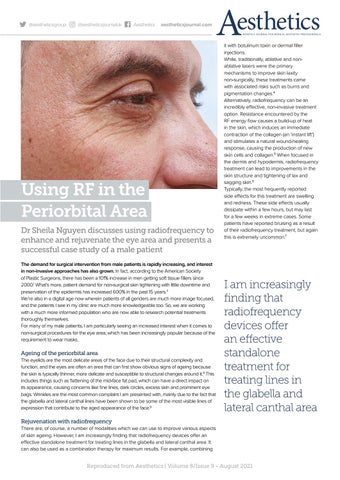@aestheticsgroup
@aestheticsjournaluk
Aesthetics
aestheticsjournal.com
Using RF in the Periorbital Area Dr Sheila Nguyen discusses using radiofrequency to enhance and rejuvenate the eye area and presents a successful case study of a male patient The demand for surgical intervention from male patients is rapidly increasing, and interest in non-invasive approaches has also grown. In fact, according to the American Society of Plastic Surgeons, there has been a 101% increase in men getting soft tissue fillers since 2000.1 What’s more, patient demand for non-surgical skin tightening with little downtime and preservation of the epidermis has increased 600% in the past 15 years.2 We’re also in a digital age now wherein patients of all genders are much more image focused, and the patients I see in my clinic are much more knowledgeable too. So, we are working with a much more informed population who are now able to research potential treatments thoroughly themselves. For many of my male patients, I am particularly seeing an increased interest when it comes to non-surgical procedures for the eye area, which has been increasingly popular because of the requirement to wear masks.
Ageing of the periorbital area The eyelids are the most delicate areas of the face due to their structural complexity and function, and the eyes are often an area that can first show obvious signs of ageing because the skin is typically thinner, more delicate and susceptible to structural changes around it.3 This includes things such as flattening of the mid-face fat pad, which can have a direct impact on its appearance, causing concerns like fine lines, dark circles, excess skin and prominent eye bags. Wrinkles are the most common complaint I am presented with, mainly due to the fact that the glabella and lateral canthal lines have been shown to be some of the most visible lines of expression that contribute to the aged appearance of the face.3
it with botulinum toxin or dermal filler injections. While, traditionally, ablative and nonablative lasers were the primary mechanisms to improve skin laxity non-surgically, these treatments came with associated risks such as burns and pigmentation changes.4 Alternatively, radiofrequency can be an incredibly effective, non-invasive treatment option. Resistance encountered by the RF energy flow causes a build-up of heat in the skin, which induces an immediate contraction of the collagen (an ‘instant lift’) and stimulates a natural wound-healing response, causing the production of new skin cells and collagen.5 When focused in the dermis and hypodermis, radiofrequency treatment can lead to improvements in the skin structure and tightening of lax and sagging skin.5 Typically, the most frequently reported side effects for this treatment are swelling and redness. These side effects usually dissipate within a few hours, but may last for a few weeks in extreme cases. Some patients have reported bruising as a result of their radiofrequency treatment, but again this is extremely uncommon.7
I am increasingly finding that radiofrequency devices offer an effective standalone treatment for treating lines in the glabella and lateral canthal area
Rejuvenation with radiofrequency There are, of course, a number of modalities which we can use to improve various aspects of skin ageing. However, I am increasingly finding that radiofrequency devices offer an effective standalone treatment for treating lines in the glabella and lateral canthal area. It can also be used as a combination therapy for maximum results. For example, combining
Reproduced from Aesthetics | Volume 8/Issue 9 - August 2021


















